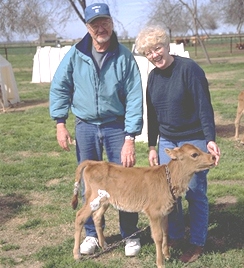Do financial incentives
for dairy workers pay off?
By Eric McMullin
California Farmer Magazine

© 1999 Gregorio Billikopf Encina
Each year we pay about $4,500 in incentives to our three milkers, and we get about $55,000 in return," says Jane Beswick, co-owner of Glenlane Jerseys in Turlock, Calif.
The Beswicks have been paying an incentive bonus for more than 11 years. Their program has evolved from paying solely on somatic cell count (SCC) scores to the current method, which parallels Hilmar Cheese Co.’s method of paying quality premiums to its producers.
In 1984 Glenlane Jerseys’ SCC was nearing 400,000, and the Beswicks knew something had to be done. But before they could implement any bonuses, they needed to upgrade their equipment, says Ken Beswick, Jane’s husband and co-owner of Glenlane Jerseys.
"The workers need to know you’re serious about your equipment, and that you’re going to give them every opportunity to earn the bonus," says Ken. So the vacuum system and pipeline were renovated, and new milk claws, a larger capacity vacuum pump and vacuum controller were installed.
Over the ensuing six years, the dairy’s SCC dropped so low that it was giving E.coli an opportunity to breed. "If you overemphasize one factor, another one can get out of hand," notes Jane. "That’s why, in 1993, we went to the current bonus encompassing three different categories."
They are:
- Somatic cell count under 200,000;
- 1 percent or less of the herd having clinical mastitis within the month; and
- bacteria samples of less than 15,000 for SPC, less than 225 for LPC and less than 225 for E.coli.
The two full-time milkers get $50 a month for each of the three goals they meet. The relief milker gets $33.33 per month per category. The total possible payout is $400 per month. "We post the quality report when we get it, and every week the milkers are up there looking at it," says Jane.
The Beswicks sell their milk to Hilmar Cheese Co., which pays up to 15 cents per cwt. for somatic cell counts under 200,000, provided minimum standards are met in the categories of SPC, LPC and E.coli. So far this year, Glenlane Jerseys has averaged just over 9 cents per cwt. in premiums.
Glenlane Jerseys began paying bonuses in 1984. By 1990 milk production had increased by 2,729 lbs. per cow. To determine how much of that could be attributed to the decreased SCC, Jane used two methods.
The first is Bliss Crandall’s at the DHIA center in Provo, Utah. Crandall estimates that each 1 percent change in the percentage of the herd below 200,000 SCC boosts the rolling herd average by 78.5 lbs. of milk. The Beswicks achieved a 19 percent increase in the number of cows below 200,000 SCC. Multiplied by 78.5 lbs. for each of the 327 cows they milked then, the net financial return due solely to improved SCC would be $61,209.
[(19 x 78.5 x 327)/100] x $12.55/cwt = $61,209.
The second method is linear score reduction. For each point reduction in linear score, there is an estimated average gain of 400 lbs. of milk from mature cows and 200 lbs. from first-calf heifers. The Beswicks dropped three points between 1984 and 1990. Therefore: [(3 x 400#/cow x 213 cows)/100] x $12.55/cwt = $32,078, + [(3 x 200#/hfr x 114 hfrs)/100] x $12.55/cwt = $8,584, for a total of $40,662.
The increase milk income was $111,994: [(2,729#/cow x 327 cows)/100] x $12.55/cwt. The average value of the two methods for estimating the impact of reducing SCC is $50,936: ($61,209 + $40,662)/2.
"Add the premiums we receive from Hilmar, and $55,000 is a pretty close estimate of the total return to us from paying a somatic cell bonus," Jane says. "Financial incentives for workers do pay off."
© 1995 Farm Progress Companies, Permission to post in this site was granted by California Farmer magazine, where article appeared November 1995, p. D8.

Articles
Table of Contents
July 27, 2000
|